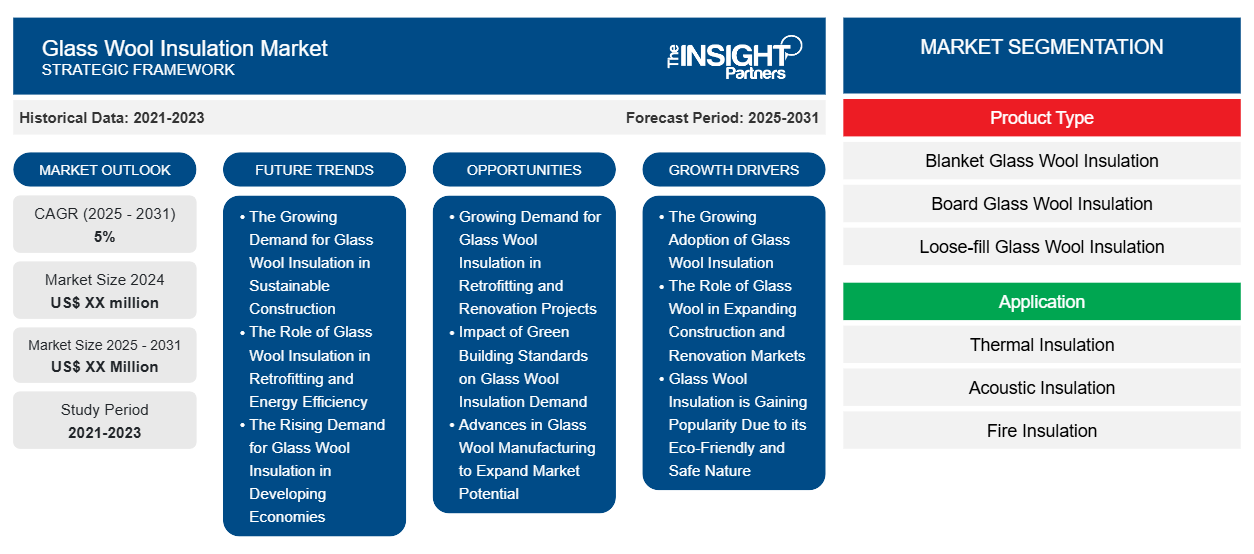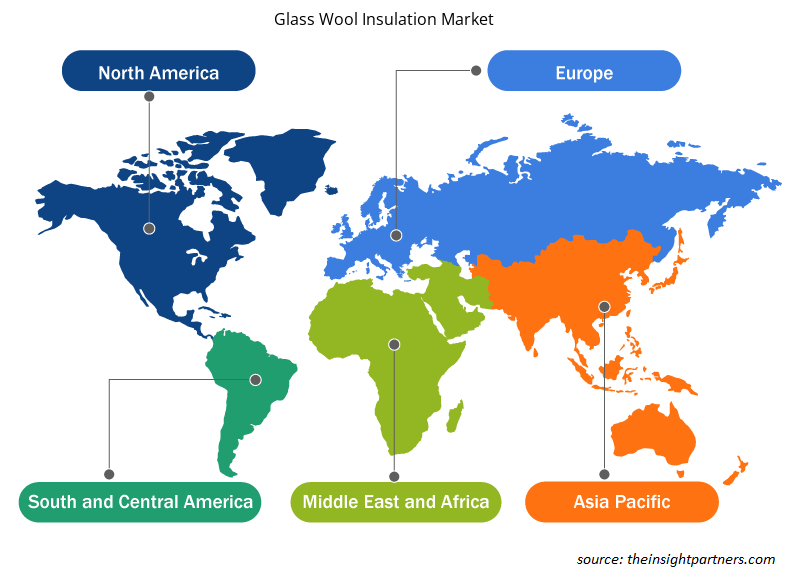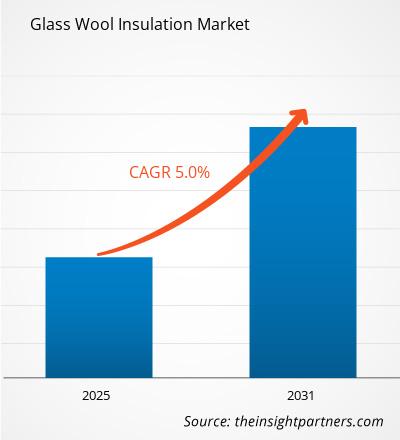预计玻璃棉绝缘市场在 2024 年至 2031 年期间的复合年增长率为 5%,市场规模将从 2024 年的 XX 百万美元扩大到 2031 年的 XX 百万美元。
报告按产品类型(毯式玻璃棉保温、板式玻璃棉保温、松散填充玻璃棉保温)进行细分。全球分析进一步细分为区域和主要国家。报告进一步根据应用(隔热、隔音、防火、其他)进行分析。全球分析进一步细分为区域和主要国家。范围涵盖所有关键细分市场的全球、区域和国家层面的市场规模和预测。报告以美元为单位提供上述分析和细分的价值。报告提供了主要市场参与者的市场状况的关键统计数据,并提供了市场趋势和机会。
报告目的
Insight Partners 的《玻璃棉保温市场》报告旨在描述当前形势和未来增长、主要驱动因素、挑战和机遇。这将为各种业务利益相关者提供见解,例如:
- 技术提供商/制造商:了解不断变化的市场动态并了解潜在的增长机会,从而能够做出明智的战略决策。
- 投资者:对市场增长率、市场财务预测以及整个价值链中存在的机会进行全面的趋势分析。
- 监管机构:监管市场政策和警察活动,旨在最大限度地减少滥用行为,维护投资者的信任和信心,维护市场的完整性和稳定性。
玻璃棉保温市场细分
产品类型
- 玻璃棉保温毯
- 玻璃棉保温板
- 松散填充玻璃棉保温材料
应用
- 隔热
- 隔音
- 防火隔热
- 其他的
终端使用行业
- 建造
- 工业应用
- 汽车
- 航天
- 能源和电力
- 其他的
地理
- 北美
- 欧洲
- 亚太
- 南美洲和中美洲
- 中东和非洲
定制此报告以满足您的需求
您可以免费定制任何报告,包括本报告的部分内容、国家级分析、Excel 数据包,以及为初创企业和大学提供优惠和折扣
玻璃棉保温市场:战略洞察

- 获取此报告的关键市场趋势。这个免费样品将包括数据分析,从市场趋势到估计和预测。
玻璃棉保温市场的增长动力
- 玻璃棉保温材料的应用日益广泛:建筑流程和设施的严格节能法规和标准迫使人们采用玻璃棉保温材料。该材料具有保温性能,有助于防止能量损失,因此是住宅、商业企业和工业建筑工程的首选。
- 玻璃棉在扩大建筑和翻新市场中的作用:玻璃棉被越来越多人接受的主要原因之一是建筑速度的不断提高,尤其是在发展中国家。此外,旨在改造旧结构的修复工程也具有节能效果,因此提高了这种材料的市场需求。
- 玻璃棉保温材料因其环保和安全特性而越来越受欢迎:玻璃棉保温材料具有不可燃性、化学安全性以及环保设计,使其适合安全的建筑实践。随着人们对所用材料的关注度不断提高,玻璃棉的益处也增强了它的吸引力。
玻璃棉保温市场未来趋势
- 可持续建筑对玻璃棉保温材料的需求不断增长:由于建筑规范和环境政策越来越严格,对可持续建筑材料的需求正在增加。由于其高能效特性和原材料的可用性,玻璃棉保温材料预计将作为一种环保措施得到推广,以控制建筑物的能源消耗。
- 玻璃棉隔热材料在改造和节能中的作用:由于旧建筑需要节能改造,玻璃棉隔热材料市场将不断增长。住宅和商业领域对玻璃棉的需求将非常大,因为对现有建筑进行改造,使用更好的隔热材料来提高节能效率是一种趋势。
- 发展中经济体对玻璃棉隔热材料的需求不断增长:随着大多数发展中经济体的持续城市化,隔热材料的性能上限也不断提高。玻璃棉价格低廉、安装方便、隔热性能好,是这些国家最受欢迎的材料之一,因此中国、印度、巴西的需求也在增加。
玻璃棉保温市场机会
- 改造和翻新项目中对玻璃棉保温材料的需求不断增长:随着对节能建筑的关注度不断提高,改造和翻新项目中对保温材料的需求也将不断增加。玻璃棉保温材料具有成本效益和高热性能,非常适合满足这些需求。这一趋势将为住宅、商业和工业领域创造重大机遇。
- 绿色建筑标准对玻璃棉保温材料需求的影响:LEED 和 BREEAM 等绿色建筑标准的日益普及为玻璃棉保温材料创造了机会,因为它因其卓越的保温性能、低环境影响和可回收性而受到认可。可持续建筑材料市场预计将增长,从而推动对玻璃棉的需求。
- 玻璃棉制造技术进步将扩大市场潜力:玻璃棉制造技术进步(例如开发更轻质、性能更高的隔热产品)将带来新的机遇。玻璃棉防火和隔音性能的提高有望扩大其在高层建筑和工业设施等专业应用中的使用。
玻璃棉保温材料市场区域洞察
Insight Partners 的分析师已详尽解释了预测期内影响玻璃棉保温材料市场的区域趋势和因素。本节还讨论了北美、欧洲、亚太地区、中东和非洲以及南美和中美洲的玻璃棉保温材料市场细分和地理位置。

- 获取玻璃棉绝缘市场的区域特定数据
玻璃棉绝缘市场报告范围
| 报告属性 | 细节 |
|---|---|
| 2024 年的市场规模 | XX 百万美元 |
| 2031 年市场规模 | XX 百万美元 |
| 全球复合年增长率(2025 - 2031) | 5% |
| 史料 | 2021-2023 |
| 预测期 | 2025-2031 |
| 涵盖的领域 | 按产品类型
|
| 覆盖地区和国家 | 北美
|
| 市场领导者和主要公司简介 |
|
玻璃棉保温市场参与者密度:了解其对业务动态的影响
玻璃棉保温材料市场正在快速增长,这得益于终端用户需求的不断增长,而这些需求又源于消费者偏好的不断变化、技术进步以及对产品优势的认识不断提高。随着需求的增加,企业正在扩大其产品范围,进行创新以满足消费者的需求,并利用新兴趋势,从而进一步推动市场增长。
市场参与者密度是指在特定市场或行业内运营的企业或公司的分布情况。它表明在给定市场空间中,相对于其规模或总市场价值,有多少竞争对手(市场参与者)存在。
在玻璃棉绝缘市场运营的主要公司有:
- 阿尔加尼姆工业公司
- 布拉德福德绝缘工业有限公司
- Chez Knauf Insulation SPRL
- 圣戈班公司
- 约翰斯·曼维尔公司
免责声明:上面列出的公司没有按照任何特定顺序排列。

- 了解玻璃棉保温市场的主要参与者概况
主要卖点
- 全面覆盖:报告全面涵盖了玻璃棉绝缘市场的产品、服务、类型和最终用户的分析,提供了整体概况。
- 专家分析:报告基于对行业专家和分析师的深入了解而编写。
- 最新信息:该报告涵盖了最新信息和数据趋势,确保了其与业务的相关性。
- 定制选项:此报告可以定制以满足特定客户要求并恰当地适应业务策略。
因此,玻璃棉保温市场研究报告有助于引领解读和了解行业情景和增长前景。尽管可能存在一些合理的担忧,但本报告的总体优势往往大于劣势。
- 历史分析(2 年)、基准年、预测(7 年)及复合年增长率
- PEST和SWOT分析
- 市场规模、价值/数量 - 全球、区域、国家
- 行业和竞争格局
- Excel 数据集
近期报告
相关报告
客户评价
购买理由
- 明智的决策
- 了解市场动态
- 竞争分析
- 客户洞察
- 市场预测
- 风险规避
- 战略规划
- 投资论证
- 识别新兴市场
- 优化营销策略
- 提升运营效率
- 顺应监管趋势




















 获取免费样品 - 玻璃棉保温市场
获取免费样品 - 玻璃棉保温市场